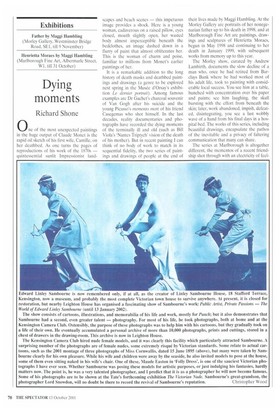Dying moments
Richard Shone
0 ne of the most unexpected paintings in the huge output of Claude Monet is the rapid oil sketch of his first wife, Camille, on her deathbed. As one turns the pages of reproductions of his work of the 1870s — quintessential sunlit Impressionist land
scapes and beach scenes — this impetuous image provides a shock. Here is a young woman, cadaverous on a raised pillow, eyes closed, mouth slightly open, her wasted body almost imperceptible beneath the bedclothes, an image dashed down in a flurry of paint that almost obliterates her. This is the woman of charm and poise, familiar to millions from Monet's earlier paintings of her.
It is a remarkable addition to the long history of death masks and deathbed paintings and drawings (a genre to be explored next spring in the Musee d'Orsay's exhibition Le demier portrait). Among famous examples are Dr Gachet's charcoal souvenir of Van Gogh after his suicide and the young Picasso's memento mod of his friend Casegemas who shot himself. In the last decades, reality documentaries and photographs have recorded the dying moments of the terminally ill and old (such as Bill Viola's 'Nantes Triptych' vision of the death of his mother). But in recent painting I can think of no body of work to match in its sequential fidelity, the two series of paintings and drawings of people at the end of their lives made by Maggi Hambling. At the Morley Gallery are portraits of her nonegenarian father up to his death in 1998, and at Marlborough Fine Art are paintings, drawings and sculptures of Henrietta Moraes, begun in May 1998 and continuing to her death in January 1999, with subsequent works from memory up to this year.
The Morley show, curated by Andrew Lambirth, documents the slow decline of a man who, once he had retired from Barclays Bank where he had worked most of his adult life, took to painting with considerable local success. You see him at a table, hunched with concentration over his paper and paints; see him laughing, the skull bursting with the effort from beneath the skin; later, work abandoned, impish, defeated, disintegrating, you see a last wobbly wave of a hand from his final days in a hospital bed. The works of this series, including beautiful drawings, encapsulate the pathos of the inevitable and a privacy of faltering communication that many can share.
The series at Marlborough is altogether different, the mementos of a recent friendship shot through with an electricity of feel ing and the discovery of a person over a few months of love — for that is what happened between Hambling and her subject.
Henrietta Moraes is best known as the model for some of Francis Bacon's most celebrated paintings, including 'Lying Figure with Hypodermic Syringe' (1963), based on photographs of her naked taken by John Deakin. Besides being some of Bacon's finest works, they belong contextually to the heyday of pre-Swinging Sixties Soho, to the world of the French Pub and the Colony, a geographical area and social terrain fast becoming as mapped as Bloomsbury or Montparnasse in its achievements, liaisons and tragedies.
Although they had met before, Hambling and Moraes were brought together again at, appropriately, the private view of a posthumous exhibition of Bacon's paintings at the Hayward Gallery, selected by the late David Sylvester in 1998. From Moraes's first sittings for the artist to her death nine months later, an extraordinary 'affair' developed, held together by Hambling's voracious visual diary of a dying woman. Her images of Moraes fall into two groups — over two dozen charcoal drawings from the life and on her deathbed: and a varied series of paintings, works on paper and sculpture made since then.
The first group is Hambling at her best. Soft to hard charcoal in commas and flickers and fractured lines capture the mercurial presence of Moraes — defiant, self-absorbed, flirtatious, downright angry or revealing a stomping-off of the mind and attention as the drawing progressed. The opulent beauty of her earlier days, with her structured bones and riveting eyes, is still apparent, engulfed by a tidal wave of often self-destructive time spent in marrying life's expectations to its reality. The drawings are neither maudlin nor sensational. This project was going to be no oneoff souvenir but carried through even beyond the cry of 'Last orders!', so familiar to Moraes. Hambling is an obsessive worker, into the morning studio no matter what; Moraes was reliably unreliable in mood and punctuality. Only when dead was she perfectly accommodating.
Maggi Hambling was a pupil in Suffolk of Cedric Morris (as Lucian Freud had been years earlier) and his extraordinary portraits, simultaneously naive and penetrating, echoing the confrontational stance of the German Neue Sachlichkeit painters of between the wars, inform Hambling's excavaton, approach (Morris too was the subject of a haunting deathbed drawing by his pupil). She was also close to Robert Medley, who taught her at Camberwell School of Art, and she preserves something of his late figurative style, her contours refusing definition, breaking into a Mannerist palsy of lines.
Hambling is also a performer, giving a rabbit-out-of-the-hat surprise to the subjects she has chosen over the last 30 years or more. Comic chuckles or black humour can sometimes disguise her manual dexteri ty and deep feeling. Sometimes the jokes misfire — broad where they should be witty. But in all she does there is a wriggling, inextinguishable vitality. She is a disconcerting, even uncomfortable artist. She walks a tightrope, one end of which is considerably lower than the other. She can dip down into bathos and caricature and move upwards to what R.B. Kitaj once described as the aim of figurative art — 'the delineation of the face and fortunes and torments of us all', While these two remarkable shows embrace both positions, it is the latter that dominates.



























































































 Previous page
Previous page